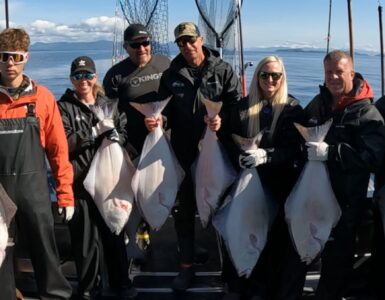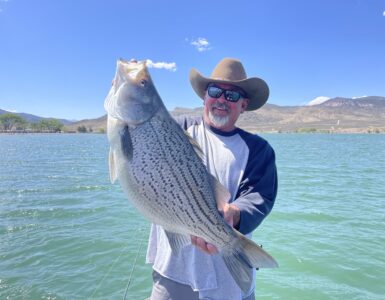(Adam) Coming up tonight on KSL Outdoors.
biologists are stocking gold in the Uintas AND…
(Adam) we are on the lower and middle Provo and we are hooking up with two guides that are going to give us some of their trade secrets. I’m Adam Eakle and this is KSL Outdoors.
(Intro) Well thanks for tuning into KSL Outdoors, I’m Adam Eakle with Mickey Anderson from Fish Tech and Mickey we are along probably the most fished river in Utah, the Provo River and today we are going to catch some fish. (Mickey Anderson, Fish Tech Outfitters) yeah we are going to meet with a couple of guides and they are great guys, they really know the river well. They’re going to show us what to use. We are going to let them set us up. (adam) they are going to give us some of their trade secrets? (mickey) they are, they are going to reveal a lot and this is going to be a great learning experience. (adam) alright well lets go learn. (mickey) let’s go.
Right now the Provo river is teaming with Anglers, and a lot of opportunity. Most fisherman have been chasing the drake hatch on the Middle Provo and seemed to have forgotten that the PMD hatch is still going on in the lower Provo.
(Brian and jeff fishing) (nats wading) (jeff) what’s that? (brian hits) (jeff) there we go! let him run.
That’s where we found guide Jeff Harwin and his client Brian.
(nats of fish splash, net fish) There we go, nice fish, what a chunker.
(Mickey Anderson, Fish Tech Outfitters) Jeff when water looks like this it’s kind of intimidating to a lot of people. It’s hard to fish. I want to know how to fish it. Set me up. (Jeff Harwin, Provo River Guide Service) ok, to start off we are going to nymph fishing. Obviously we don’t see any fish rising. So we’ll wait for that later to throw the dry fly. Basically what we are going to do is take a thirty pound leader, just the butt section and we are going to put the indicator on first and what this allows us to do is measure the depth of what we are going to be fishing. Right here we’ve got a run that drops about 4-5 feet, so we are going to set up about an 8 foot rig. (mickey) so about twice the depth of the water? (jeff) about twice the depth yeah.
(jeff) especially when I’m nymph fishing, I know a lot of people want to throw a tapered leader and what that does is create a lot of drag and it takes more weight to get it down. So what we are going to do is kind of lighten it up and un-taper the leader and put a knot right here.
(Jeff) and I’m going to go 4X fluorocarbon for nymphing.
(Mickey) now you just did an over hand knot? (jeff) I did just do an over hand knot. I’m going to put the 4X
(Jeff) tip in here and then tighten that down and all I’m doing here is an improved cinch knot.
(Jeff) now you’ve got your first tag. And what I like to do Mickey is I don’t like to put my fly on the top one. I always like to put my fly on the bottom tag. So I’ll clip this one and repeat the process.
(Jeff) so what I’m going to do is add two PMD numphs. This fly is a fly you can get right at Fish Tech and this one is Mercer’s Trigger Nymph. What I like to do is have kind of an attractor, little bit flashy for this fast water and then throw something a little more subtle behind it. (mickey) does it matter flash top, flash bottom? (jeff) I always put the flashy one on top.
(Mickey) that one is a lot of flash, the second one a little more subtle? (jeff) the second one is going to be a little foam pattern we call the pee-man demon and it’s kind of a mayhem pattern, it’s just one that I tied up yesterday.
(Jeff) now if we were on the middle Provo, I wouldn’t be throwing any beads. On the lower they will still eat it. What I do is just enough that I can get the weights on there. (mickey) just a little over hand knot. (jeff) i do a little over hand knot and the reason I do that is I don’t want the weights to slip. If it gets caught on a rock or just kind of drifting down. I’ve got my weights right here and I’m using #1 split shot and I’m going to go about 3-4 weights.
Jeff says, casting his heavy Provo River bounce rig is not like casting a dry fly. It takes three easy steps to keep you from tangling up.
(Jeff) pick it up, pause, and then chop forward. That’s it, so I’m going to pick it up, pause and then chop forward and let it drift in here.
Now it’s Mickey’s turn to try the rig.
(mickey hit) there we go. good one to. (jeff) nice, nice. (mickey) he’s off. (laughs) well Jeff that was great information, that was a good fish. I’m going to take this and use it on different parts of the river and use it for a long time to come. Thanks for all your help today.
to get ahold of Jeff or to have him guide you for a day on the river, log onto provoriverguides.com. Coming up…
(Walter) there you go.
More tips from guides, this time on the middle Provo. AND
There’s gold in them there hills, as the DWR plant a unique trout in a high Uinta Lake. Those stories just ahead, but first tonights quiz question.
*********************************
(intro) (adam) you got another one on? (mickey) oh yeah, that’s a good fish. (adam) yeah, oh we’ve got a double on over there nice. Welcome back to KSL Outdoors, I’m Adam Eakle, Mickey you are landing one of the better fish today. Definitely one of the more pretty fish. We are going to meet a guide to learn some more tactics? (mickey) we are, Walter Foster, he’s going to help us out a lot. He’s a guide on this river, spends a lot of time here, he’s going to show us a little bit more. (adam) something different. (mickey) a little different.
(Mickey Anderson) Walter I was just up on the river with a dry. I stunk it up and there is fish all over. What am I doing? (Walter Foster, Trout Tales Guide Service) well lets figure it out. (mickey) first what fly should I have been using? (walter) the first thing you want to do is get an observation of what’s going on in the water. Generally right on top here you are going to see some bugs hatching and right now what we have is some PMD, little yellow mayflies. So what we are going to try and do is match the size, shape and color.
(Walter) and then the other thing is this time of year we have the green drakes coming off. So, this green drake is a big visible fly, easy to cast. And we are going to use that for our demonstration to see the drift and everything.
(mickey) with that fly that big, to get it to turn over, what size tippet are you going use? (walter) on the middle provo, these fish get a lot of pressure. I kind of tell everyone that they have their PHD’s. So what I like to use for say this green drake is I’ll start off with 5X tippet and I’ll be using a tapered leader that’s 10-12 feet long.
(Mickey) How long is your tippet? (walter) tippet is going to be about 20-25 inches.
(Walter) the biggest goal with dry fly fishing is achieving a drag free drift. And there is a lot of different steps you have to do to achieve that drag free drift. Let’s start with an upstream presentation.
(walter) now with this cast you want to go 10-2, get a nice tight cast, you want to get that fly line to turn over. And then do a few false casts and then when I present the fly I’m gong to lay it down and then what I’m going to do is strip the fly back to me at the speed of the current.
(Walter) I want that dry fly to drift the same speed of the current, so that fly to the fish looks like it has no strings attached.
(Mickey Anderson) hey Walter I know the bounce rig is a killer way to fish the provo but is it the only way you nymph fish the provo? (walter) no, another great method is called a tradition nymph rig. Another name for it is the in-line rig. What we are doing here is putting our split shot above our triple surgeons knot. We are using about a 8-9 foot leader as well and we are using a strike indicator. Same thing, twice the depth of the water so we do a triple surgeons knot we pinch some weights on above that knot to keep them sliding down to the fly. And then what I like use is 12/12 and 12. So there is 12 inches in between the split shot and your point fly which is going to be your bigger fly and then we are going to do another 12 inches to your dropper here.
(Walter) with this rig with the in-line, the bigger fly is tied up top and the smaller fly is trailed down below.
(Walter) What I use with my clients a good analogy to get them familiar with the set up of the cast is I mention the Statue of Liberty, Lady Liberty holding a torch in her hand. That’s your position for casting. So what we are going to do is take the arm, we are going to bring it up here, up high, roll it over the shoulder, line hand comes under the finger, we are going to mend, keep our rod tip high and we are going to watch our indicator start ticking and that’s a good indication that we are getting the drift that we need.
(hooking fish) there you go! Just had to put a little more weight on there.
(Walter) now setting the hook with a nymph, you want to set the hook downstream. These fish are facing upstream in the current, waiting for small nymphs, worms to come down the drift. So they are sitting there stationary. If you pull straight up or upstream, a lot of time those flies will pull out of their mouth. So it’s really important when you do get that strike to get a quick, sweep downstream for the hook set.
(Tag) Boy that is a lot of information to digest. If you want to check it out or review it, you can always check our outdoors page at KSLTV.com. Hey Mickey is over here, I know he’s catching more fish. Lets turn it over to him now for tonights Fish Tech fish report.
********************************
(intro) “There he is a little brookie. Welcome to the High Uinta’s I’m Adam Eakle. You know these little lakes and streams are perfect this time of year to escape the heat and catch some nice little fish, like this brook trout here. But the division is also trying to give anglers a new opportunity by stocking a fish you don’t see very often in Utah.”
(Chris Penne, DWR Aquatics Biologist) “They are native to the Sierra Nevada’s in CA. We’ve only got them in just a few small tucked away areas in Utah and so it’s just one of those unique fish that people like to scratch off their list and say they’ve caught and further they are just beautiful fish.”
The DWR is loading up thousands of six to nine inch golden trout for a four mile trek to Echo Lake in the high Uintas.
(Chris Penne) “A lot of times we stock them by air, but in this case we’ve got larger fish, that are too big to drop safely so we are actually going to pack them in on ATV’s.”
The DWR began stocking golden trout in the Uinta Mountains back in the early 1920’s. The fish did really well until about the 1950’s when brook trout were either stocked or invaded the lakes. Brook trout eventually out competed the golden trout and the golden populations crashed.
(Paul Thompson, DWR N. Region Aquatics Manager) “So in the 60’s and 70’s we began stocking again, but they kind of fell the same fate.”
(Paul Thompson) “So we only have two remnant populations remaining in Utah. Echo Lake and there is a few lakes in the Atwood Creek drainage in the Uinta River on the South Slope of the Uintas.”
(Hatchery guys) Which way is easier.
(Adam) “It’s been awhile since you’ve stocked them here?” (Wes Pearce, Kamas Fish hatchery) “It’s been since 1977. They’ve been holding on though. Guys have still been catching goldens here, so hopefully we can just supplement the population a little bit.”
(Wes Pearce, Kamas Fish hatchery) “They hauled really well actually for as a rough road it is getting in here.”
(Robert Black, South Weber) “We just came up to catch some brookies and some golden.” (adam) You knew that there were some in here? (robert) “yes , we’d done some research on-line.”
Robert grew up catching golden trout in the Sawtooth mountains of Idaho. They arrived just in time to see the goldens swim away.
(Robert Black) (adam) “What is it about the golden trout?” (robert) “It’s like the white whale, it’s such a unique fish and they are so rare, you can never find them. But when you do, and you get into them, they are really fun to catch.”
(Paul Thompson) “They are going to be under the state wide regulation so if somebody catches a few and wants to keep them great, but right now numbers are low so I’ll leave that up to the angler. If you want to come back up here through the years and catch more, the more we could leave in here would be best. But it’s really up to the angler. If they catch one and they want to take it home, that’s great.”
(Paul Thompson) “The catch and release record came out of this lake, it was eleven and a quarter inches in 2008. So we might be, hopefully seeing that broken here in the near future out of Echo Lake. Maybe we can get a twelve to thirteen incher.”
(Tag) “Biologists had hoped to put about three thousand trout here at Echo Lake, turns out they put in about forty eight hundred, six to eight golden trout. A pretty unique opportunity, get your family, your friends, you kids, like the Blacks and catch some of these unique fish. Time now to dive into tonight’s Utah Field Guide.”







Add comment